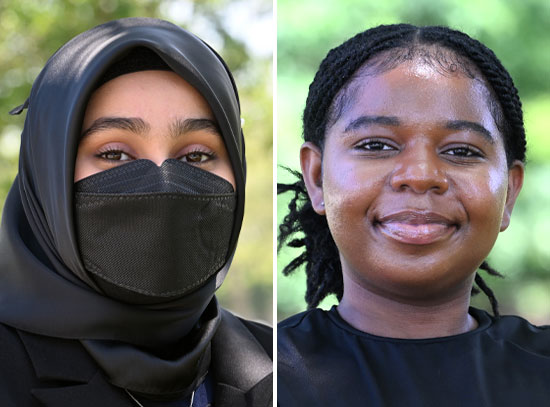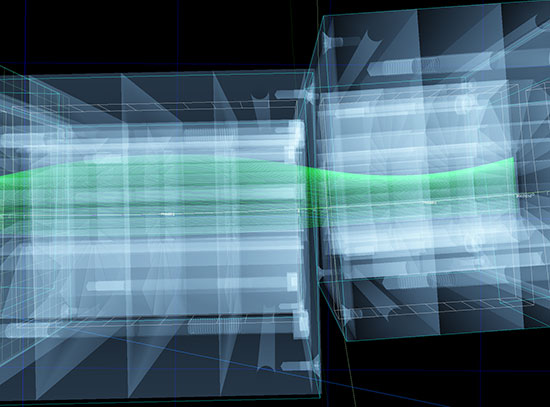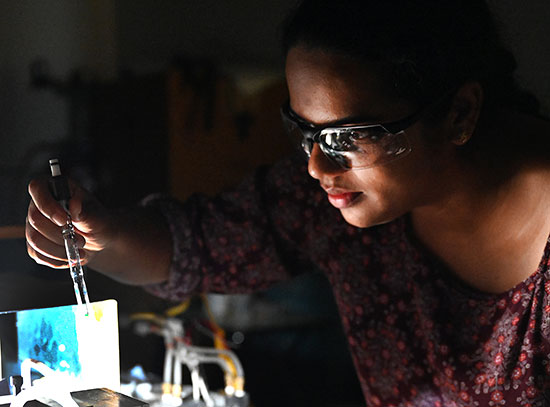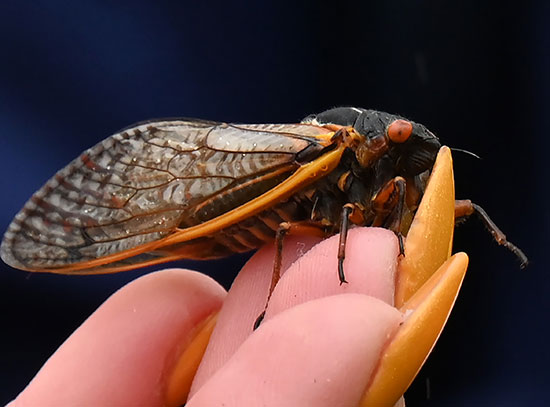NSLS User Profiles: Women in Science
September 23, 2014
This is part of a series of profiles on users at the National Synchrotron Light Source (NSLS). First operated in 1982, NSLS has accommodated more than 18,400 unique users in its lifetime as a Department of Energy user facility (see NSLS user stats). After 32 years of distinguished operations, NSLS will shut down on September 30, 2014. Replacing it is NSLS-II, which has been under construction since 2009 and is on track for early completion. When fully built out, NSLS-II will accommodate 60-70 beamlines and host over 4,000 users every year.
Meet Tiffany Victor, Ph.D. candidate at Stony Brook University, and Megan Bourassa, two years past her Ph.D. from Stony Brook and now a postdoc at Burke Medical Research Institute.
Tiffany Victor, Stony Brook University
#IMG1#
In its standard boilerplate, Stony Brook University talks about offering its students "significant research opportunities." In fact, according to statistics gathered by the Photon Sciences User Administration Office, Stony Brook sends the most users to NSLS and will likely have the same distinction at NSLS-II. What has access to world-class facilities meant for you, a Stony Brook graduate student working on a Ph.D. in chemistry?
For me, it means that creativity and “outside the box” thinking are not limited by a lack of resources. BNL has been a one-stop shop for all of my scientific needs; everything that I need is literally within walking distance.
Although my research is primarily concentrated at NSLS using the infrared beamlines U2B/U10B, I have been exposed to several other synchrotron techniques, including x-ray fluorescence microscopy, x-ray solution scattering and other types of absorption spectroscopy. Future research plans include the use of BNL’s PET (positron emission tomography) facilities and possibly facilities at the CFN (Center for Functional Nanomaterials).
A major part of my research project is based on developing an infrared method to collect data from plants grown on infrared-compatible materials. The machine shop and access to 3D printing have been instrumental in bringing designs to life for such a tailored project.
Above all these tools are the scientists and staff who work here, who have expertise in all areas. Being here definitely encourages collaborations and scientific discourse.
Finally, I think my favorite part about access to the synchrotron is seeing how other users use the same tools to answer a diverse set of research questions.
What is your research at NSLS?
Broadly speaking, our research group, led by Lisa Miller, mainly focuses on the study of the chemical makeup of cells and tissues using synchrotron-based infrared and x-ray imaging.
The main goal of my research project is to develop plants that can be grown on marginal lands in a sustainable and well-understood manner in an effort to increase biomass for biofuel production.
To do this, we need to understand how the nutrient distribution changes near a plant’s roots under different environmental conditions. If we could understand how the chemical makeup changes and relate it to phenotypic changes, then it is possible to make inferences regarding optimal growing conditions and to proteins involved in the transport of essential nutrients for a plant’s growth.
To make this possible, we use infrared imaging to spatially map out these nutrient changes in plants grown by our collaborator, Leland Cseke from University of Alabama-Huntsville. What’s great about using this technique is that we can detect nutrient changes below the physiological amount that the plants need.
Do you have plans to use NSLS-II? What advantages will the new facility offer you?
Yes, the beamlines High Brilliance X-ray scattering for Life Sciences, or LiX (PDF), and possibly Full-Field Infrared Spectroscopic Imaging, or IRI (PDF). LiX will be offering high throughput solution scattering with simultaneous SAXS/WAXS with a 1 micron spot size. This will be important for resolving the structure of the membrane proteins involved in nutrient transport across plant membrane. It will be possible to reveal how the structures of these proteins change in response to external stimuli within seconds.
The infrared imaging beamlines will offer micromolar detection sensitivity (1-5 um) with pixel deconvolution. With higher brightness and low noise from NSLS-II, we can expect to see more subtle changes in nutrients near plant root hairs and micro-organisms all done in a shorter acquisition time.
Unfortunately, these infrared beamlines most likely won’t be built ’till after I’m done with the graduate program. But I can look forward to applying for beamtime!
Megan Bourassa, Burke-Cornell Medical Research Institute
#IMG2#
You came to NSLS as a Ph.D. student at Stony Brook University, which sends more users to NSLS than any other institution. NSLS is about to shut down. What was your experience there?
A big part of why I went to Stony Brook is because of BNL. As an undergrad, I was visiting my uncle on Long Island. He knew I liked science and wanted me to see the the lab. I got a tour of Brookhaven and thought the prospect of doing at least some of my graduate work there sounded like an amazing opportunity. Later, when I was looking for a graduate advisor, I specifically sought someone doing neuroscience related work, and Lisa Miller’s lab was a great fit. Working at NSLS significantly has enhanced my training as a scientist by providing me with the opportunity to work with unique methods and highly specialized techniques, such as x-ray fluorescence and infrared microscopy. It also allowed me to interact with a number of accomplished scientists, who have provided me with the knowledge and support to succeed in my research.
So, Dr. Bourassa, what are you doing now?
Lisa certainly encouraged my interest in Alzheimer's disease. I am currently working at the Burke Medical Research Institute, affiliated with Weil Cornell, the medical school of Cornell University, where I am focused on the discovery of new drug treatments and their mechanism of action for neurological conditions, including stroke and Alzheimer’s disease. Many of the most promising drug candidates are not only capable of blocking or enhancing the function of specific enzymes, but also are able to bind metal ions, such as iron or copper. One of our goals is to determine if binding metal ions and potentially altering metal content contributes to the drug’s effectiveness in the brain. Specifically, I have been using x-ray fluorescence microscopy and x-ray absorption microspectroscopy at NSLS beamline X27A to determine if these drug candidates alter the metal content in the brains of mice that have received a hemorrhagic stroke.
NSLS-II has been on a fast-track toward completion. What does the new facility offer to you?
I definitely look forward to being a user at NSLS-II. I’m especially interested in beamlines SRX (Submicron Resolution X-ray Spectroscopy), HXN (Hard X-ray Nanoprobe), XFM (PDF) (X-ray Fluorescence Microprobe) and IRI (PDF) (Full-Field Infrared Spectroscopic Imaging). In addition to using NSLS, I have collected data at the APS (Advanced Photon Source at Argonne National Laboratory) at beamlines with higher spatial resolution and faster data acquisition times. NSLS-II will be an even greater improvement in terms of resolution and speed and, better yet, it will be closer to home!
2014-5228 | INT/EXT | Newsroom








